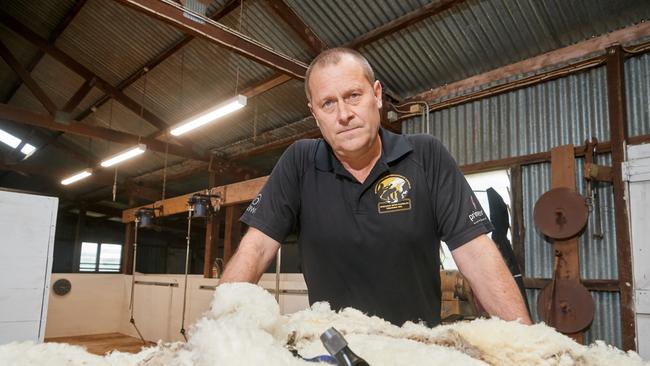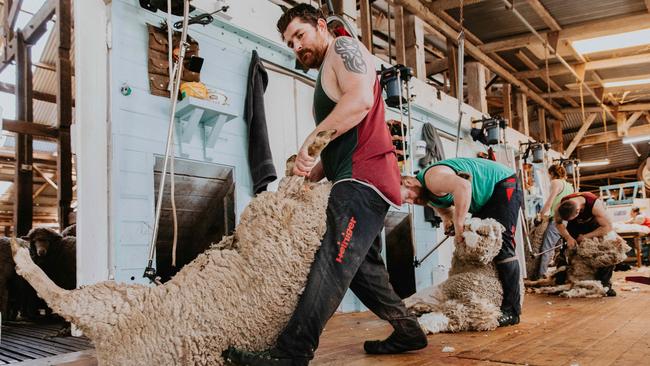Shearing contractors say sheep weights are getting bigger
Shearers are shunning young ewes the size of poddy calves saying genetics are “out of control” and farmers will be charged premium shearing rates.
Ewes are getting bigger, with the supersizing of crossbred and composites now a major concern for the shearing industry to the point some mobs are already being shunned by shearers.
Stories of farmers having to pay extra per head to have hefty ewes shorn, or shearers just walking away from some sheds, has a basis of truth, shearing contractors confirmed this week.
Coming in the wake of the industry celebrations of record money for big 1½-year-old first-cross ewes at this year’s special sales at Naracoorte, Bendigo and Corowa, it does raise questions about the balance between size and profit versus practicality when it comes to prime lamb breeders.
“The amount of size and weight shearers have to drag across the board has just got ridiculous,” said Glenn Haynes, a shearer and wool-handling trainer with the Shearing Contractors’ Association of Australia.
“It is an issue that comes up every single day. The shearers will go out the back to look at the sheep and come back and say, ‘come and have a look at the size of these’, and honestly, sometimes you wonder how they are going to be able to drag them out all day.
“Shearers are saying they won’t go back to sheds again — it is happening quite a lot across the southeast (of Victoria and South Australia).”

Similar comments were made by shearing contractor Barry Clark, Statewide Shearing, who runs teams across Victoria and NSW.
“There is no question that sheep are getting bigger,” Mr Clark said.
“At the end of the day genetics have just got out of control and you are now getting young ewes that are sized like poddy calves.”
Expecting shearers to constantly drag and manhandle ewes that weighed more than the average person wasn’t sustainable.
“You see mobs of ewes at 90, 100 or even 110kg,” Mr Clark said.
“The average shearer is probably 80kg to 85kg, so you’re asking them to drag out more than their own body weight times 160 or 180 (sheep shorn in a day).”

Mr Clark said the reality for farmers running super-sized flocks was that they would have to pay premium shearing rates, particularly if they wanted ewes shorn in the peak season of spring, or shift to months when shearers didn’t have as much work and couldn’t be as selective.
And for farmers with inadequate shearing facilities and big sheep — well, contractors said they would just struggle to get their mobs to the top of the work list.
The return of wet conditions and excess feed which has sheep in fat condition, coupled with Covid-19 which closed state and international borders and exaggerated the shearer shortage, has really put the spotlight on the shearing issue and ewe size.
Comments about the sheer size of ewes were made at recent store markets, including by one farmer who has a son who shears and was caught between admiration and concern.
“There is only one thing wrong with this yarding,” he told The Weekly Times as he watched the sale of 1½-year-old first-cross ewes at Bendigo.
“They are too big, beautiful, but getting too big.”
The biggest ewes sold at these special sales averaged 85kg as rising 1½-year-olds, with a lot of the lead runs from 68kg to 80kg liveweight.
It prompted The Weekly Times to investigate data on sheep weights.
All the figures show how sheep weights are creeping up, although the data tends to be fairly broad-stroke and can’t really be drilled down into to show how many big animals (over 30kg carcass weight) are being sold.
Carcass weights are collected by the Australian Bureau of Statistics, but is an average of all sheep processed from light Merinos to big crossbreds.
Go back 10 years and the average carcass weight was listed at 21.66kg. Five years ago it had edged up to 22.71kg. This year it is tracking at 24.39kg which is the highest on record.
There is also data collected via the National Livestock Reporting Service from the major weekly prime markets.
In October the average weight for 177,754 ewes assessed by NLRS reporters was 26kg carcass weight, which is at the top of the weight list; the heaviest weight record in any month in recent seasons being 27kg.
Go back to October 2013 and the average was 22kg. So the trend of sheep weights creeping up is consistent.

AuctionsPlus was also able to provide some weight data by sheep breed and age, as sheep are weighed and the data captured as part of the online listing process. The results are detailed in the table on this page.
The figures show first-cross ewes averaging 70kg and 73kg during the month of October in the past two years, noting that as an average there would be a considerable number of sheep over 80kg liveweight.
What stands out is the upward weight curve of young ewes or hoggetts, showing how the latest generations are capable of reaching bigger sizes, particularly in good seasons.
Mr Haynes said 75 per cent of shearing injuries or workcover claims were connected to the ‘catch and drag’ phase of getting sheep from pens onto the shearing board.
In recent weeks Mr Haynes has been involved in trialing a new Automatic Shearing Delivery Race, which has been designed with the help of leading shearers and funded through Australian Wool Innovation.
The prototype machine uses a race-like system to deliver the sheep to the shearer, and incorporates pneumatics that can hold and tip the sheep into position ready for the shearer to start.

The aim is to reduce the amount of physical work required to get sheep from catching pens to the shearing plant.
Mr Haynes said trial work was yielding positive feedback, although the machine was still some time away from being commercially available.
“The shearer involved in the trial said the difference on his hips, shoulders and arms (from not having to catch and drag) was phenomonal,” he said.
Ultimately farmers have to make their own decisions regarding the size of sheep they are running, and the conundrum of profit versus practicality.
Big ewes breed big lambs, but also come with the issues of feed requirements and maintenance and now, also shearing issues.




